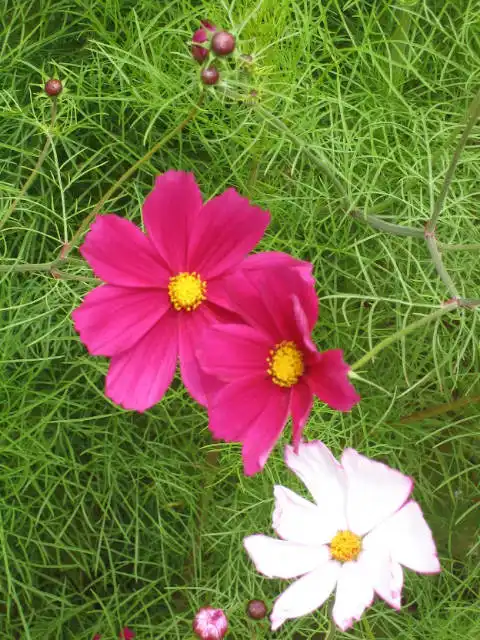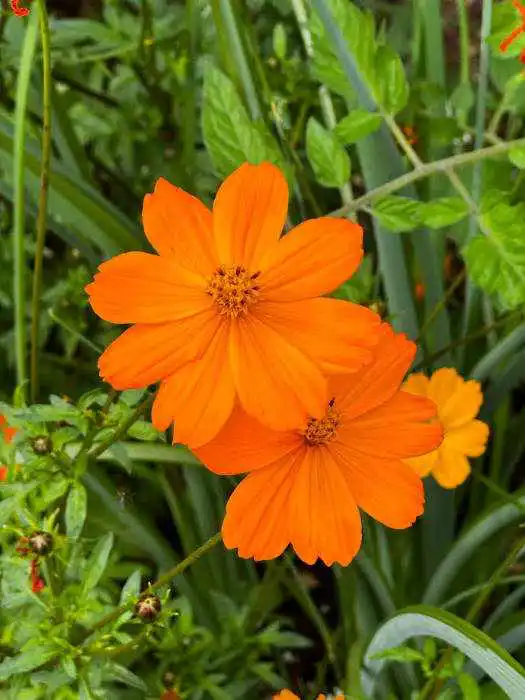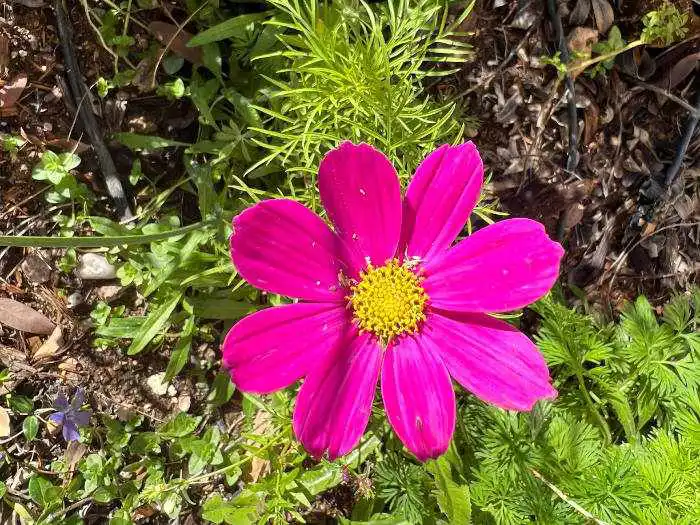Cosmos are wild looking sun loving annual flowers. From the Asteracae family they have daisy like blooms in various colors. These cheerful, easy-to-grow flowers that can turn any space into a beautiful flower garden.
This post may contain affiliate links. Please see my disclosure policies. If you purchase after clicking an affiliate link we may receive small commission at no cost to you. As an Amazon Associate I earn from qualifying purchases.
Why We Love Cosmos
Cosmos are one of my go to annual flowers for a summer garden. They are perfect for those looking for an untamed wild flower garden look, a cut flower garden or a cottage garden style. They are considered annual flowers, however mine have reseeded and by the following June have taken over my entire herb and flower garden.
If you’re gardening in Phoenix there are not too many annual flowers blooming in June or July, so this is a great addition to add to your summer flower garden. They are available in some stunning bold colors and the butterflies love this flower.
Where Can Cosmos Grow?
They’re pretty adaptable flowers and can be grown in USDA gardening zones 2 through 11. So, you can grow these pretty flowers just about everywhere.
Cosmos are great flowers that still bloom here during the hot Arizona summer. They also attract butterflies.
When to Plant Cosmos?
Cosmos are frost-sensitive, so plant after the danger of frost has passed in your area. In Phoenix or gardening zone 9b, plant cosmos March through July.
Cosmos grow well when directly sown into the ground. For continuous blooms, consider succession planting. Sow seeds every couple of weeks from spring to early summer.

How to Plant Cosmos
Cosmos love the sun, so find a spot in your garden that gets at least 6 to 8 hours of sunlight each day. If you’re in a hot climate, like Phoenix Arizona plant them where they will have morning sun and afternoon shade.
Choose a well-draining spot with full sun. Cosmos aren’t picky about soil, but they do need well-draining soil. Amend heavy clay soil.
From Seed
Scatter the seeds directly on the soil surface and lightly cover them with a thin layer of soil. Space them about 12-18 inches apart to give them room to grow.
Water the seeds. Keep the soil moist until the seedlings emerge, which should take about 7-10 days.
How to Care for Cosmos
Cosmos are low-maintenance flowers and relatively pest-free. Occasionally, they might get aphids or powdery mildew, but these are usually not severe and can be managed easily.
Water young plants regularly, but once established, cosmos are quite drought-tolerant. Water them deeply but infrequently to encourage deep root growth.
To keep the blooms coming, regularly deadhead (remove) spent flowers. This encourages the plant to produce more blooms.
Tall varieties might need staking to keep them upright, especially in windy areas. Use bamboo stakes or garden twine for support.

Types of Cosmos
There are several types of cosmos to choose from. Some popular varieties include:
Cosmos bipinnatus
Known as garden cosmos, these are the most common. They come in colors like white, pink, magenta, and crimson.
Cosmos sulphureus
These are typically yellow, orange, or red and are more heat-tolerant than bipinnatus. These grow very well in Phoenix.

Cosmos atrosanguineus
Also called chocolate cosmos, these have a deep, dark red color and a delightful chocolate scent!
Good Companion Plants for Cosmos
- marigolds
- sunflowers
- vegetables
- zinnias
Marigolds
Marigolds attract beneficial insects and deter pests, making them great companions.
Sunflowers
Sunflowers provide a striking backdrop for cosmos, creating a layered garden effect.
Vegetables
Plant cosmos near warm-season veggies like tomatoes and peppers. They attract pollinators that help boost vegetable yields.
Zinnias
These summer flowers look great when grown with zinnias. Zinnias and cosmos together create a dazzling display for your summer garden.

The Benefits of Growing Cosmos
Cosmos are easy to grow making them a great choice for both beginner and advanced gardeners. Cosmos are not just pretty faces in the garden; pollinators like bees and butterflies love these flowers.
They bloom from summer through fall, providing consistent color and beauty. One of the few annual flowers still blooming in the hot Arizona summers.
Cosmos are wonderful cut flowers. Grow extra, so you can bring their cheerful blooms indoors. Another benefit is that the plant can help improve soil quality over time, as their roots aerate the soil and add organic matter when they decompose.
Whether you’re planting them in garden beds, borders, or containers, cosmos will reward you with their abundant blooms and easy-going nature

